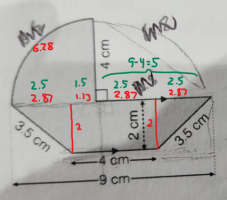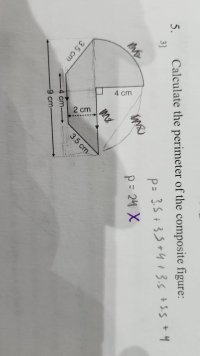You are using an out of date browser. It may not display this or other websites correctly.
You should upgrade or use an alternative browser.
You should upgrade or use an alternative browser.
I need help: "Calculate the perimeter of the composite figure"
- Thread starter Nauman
- Start date
- Joined
- Feb 4, 2004
- Messages
- 16,583
Calculate the perimeter of the composite figure
What are your thoughts? What have you tried? Where are you stuck? ("Read Before Posting")
For instance, you used the formula for the circumference of a circle to find the length of the arc of the portion forming one-quarter of a circle. You split off the triangles on either end, using the given lengths of the hypotenuses and legs, along with the Pythagorean Theorem, to find those values. And... then what?
Please be complete. Thank you!
Dr.Peterson
Elite Member
- Joined
- Nov 12, 2017
- Messages
- 16,087
First, they are lying to you. If you apply the Pythagorean theorem, you will find that the numbers are inconsistent. You have to choose which numbers to believe. (For example, if the other numbers are correct, then the 3.5 should be about 3.2. My guess is that you are expected not to use Pythagoras, but to trust all the numbers written otherwise, which means ignore the right triangles.)Calculate the perimeter of the composite figure
Second, your work suggests that you may have omitted the arc length (and maybe got something else wrong too).
Please show the details of your work. Which segment does each length you used represent, and why?
Last edited:
@Dr.Peterson you are right, i didn't use pythagoras here
- Joined
- Feb 4, 2004
- Messages
- 16,583
First, they are lying to you. If you apply the Pythagorean theorem, you will find that the numbers are inconsistent.
Huh. I hadn't even thought to check that, but you're right; the triangles do not work out. So, after finding the arc length, maybe use the fact that, of the total length of 9, the circular part has cut off a length of 4, leaving the rest of that top side of the trapezoid to be 5.
(I *hate* when exercises are written as sloppily as this! "Hey, student! Imma grow your love of mathematics by giving you something that's mathematically wrong! Ha, ha!")
Dr.Peterson
Elite Member
- Joined
- Nov 12, 2017
- Messages
- 16,087
That's good, except that 2*3.14 = 6.28!here is the solution i came up with
3.5+3.5+4+4 for all given sides = 15
arc or the circle = 2pie = 2*3.14 = 6.18
15 + 6.18 = 21.18
now total base is of 9
arc of the circle's radius is 4 so base should be 4 as well
9-4 = 5
21.18+5
26.18
Here is my labeled figure:

The red is my work, ignoring the 9 cm total length; I get (working counterclockwise from the far left)
3.5 + 4 + 3.5 + 2.87 + 2.87 + 4 + 6.28 = 27.02
The outer 2.87s are from the Pythagorean theorem, the 1.13 is 4 - 2.87, and the middle 2.87 is 4 - 1.13. The total length is 9.74.
The green is my work ignoring the 2 cm height, as you are doing -- in effect taking the 9 as coming from rounding of 2.87 down to 2.5. If the 9 and 3.5 were correct, then the 2 would really be 2.45 (i.e. [imath]\sqrt{6}[/imath]). This way, my answer is
3.5 + 4 + 3.5 + 5 + 4 + 6.28 = 26.28
If we ignore the 3.5 cm diagonals, then we just replace the 3.5s with 3.20 and get
3.2 + 4 + 3.2 + 5 + 4 + 6.28 = 25.68
I'm very curious which answer (if any of these) they consider "correct". The problem itself, of course, is wrong.
I see problems like this occasionally in low level courses, and assume they are trying to be nice to the student, who perhaps is assumed not to know (or want to use) Pythagoras. But the least they could do is to round appropriately, calling it 3.2, which is quite close, rather than 3.5. And why include the 2 if they don't want you using it?
Thank you for your responseThat's good, except that 2*3.14 = 6.28!
Here is my labeled figure:
View attachment 36897
The red is my work, ignoring the 9 cm total length; I get (working counterclockwise from the far left)
3.5 + 4 + 3.5 + 2.87 + 2.87 + 4 + 6.28 = 27.02
The outer 2.87s are from the Pythagorean theorem, the 1.13 is 4 - 2.87, and the middle 2.87 is 4 - 1.13. The total length is 9.74.
The green is my work ignoring the 2 cm height, as you are doing -- in effect taking the 9 as coming from rounding of 2.87 down to 2.5. If the 9 and 3.5 were correct, then the 2 would really be 2.45 (i.e. [imath]\sqrt{6}[/imath]). This way, my answer is
3.5 + 4 + 3.5 + 5 + 4 + 6.28 = 26.28
If we ignore the 3.5 cm diagonals, then we just replace the 3.5s with 3.20 and get
3.2 + 4 + 3.2 + 5 + 4 + 6.28 = 25.68
I'm very curious which answer (if any of these) they consider "correct". The problem itself, of course, is wrong.
I see problems like this occasionally in low level courses, and assume they are trying to be nice to the student, who perhaps is assumed not to know (or want to use) Pythagoras. But the least they could do is to round appropriately, calling it 3.2, which is quite close, rather than 3.5. And why include the 2 if they don't want you using it?
Actually this was sent to me by a friend of mine, whose little son needed help
I managed to do it though i haven't touched maths for last 20 years

